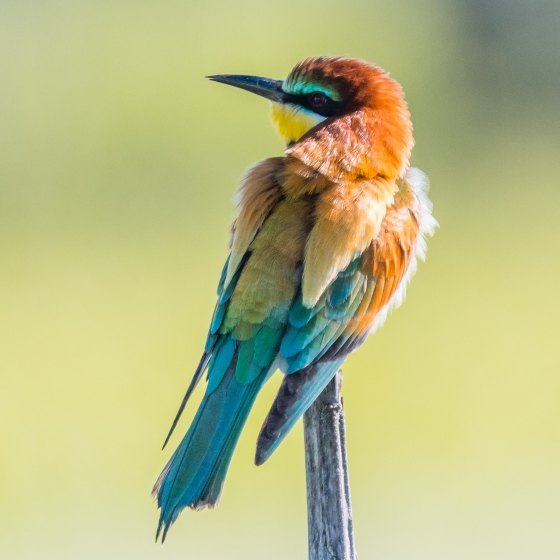Bee-eater

Introduction
With its brightly-coloured plumage the Bee-eater delivers a sense of the exotic. While most often seen as a rare visitor there have been several high profile breeding attempts in recent years.

Key Stats
Identification
Songs and Calls
Call:
Status and Trends
Conservation Status
Population Change
Historically, this species has been a scarce migrant to the UK, but the number of breeding records has increased recently with breeding attempts occurring in 2002, 2005 and 2006, and then two pairs nesting in both 2014 and 2015 and three pairs in 2017 (RBBP data). It is still unclear whether or not these records represent the early stages of colonisation of the UK.
Distribution
Bee-eaters are scarce passage migrants and very rare breeders. During 2008–11 there is a wide scatter of breeding season passage birds but none attempted to breed. More recently two pairs successfully nested in a quarry in North Norfolk in 2022.
or view it on Bird Atlas Mapstore.
European Distribution Map
Seasonality
Bee-eaters are scarce spring overshoot migrants and very rare breeders. Most records are from late spring into summer, with reporting higher than the historical average due to a well-publicised breeding event in 2022.
Weekly pattern of occurrence
The graph shows when the species is present in the UK, with taller bars indicating a higher likelihood of encountering the species in appropriate regions and habitats.

Movement
Britain & Ireland movement
European movements
EuroBirdPortal uses birdwatcher's records, such as those logged in BirdTrack to map the flows of birds as they arrive and depart Europe. See maps for this species here.
The Eurasian-African Migration Atlas shows movements of individual birds ringed or recovered in Europe. See maps for this species here.
Biology
Productivity and Nesting
Nesting timing
Egg measurements
Clutch Size
Fledging
Survival and Longevity
Survival is shown as the proportion of birds surviving from one year to the next and is derived from bird ringing data. It can also be used to estimate how long birds typically live.
Classification, names and codes
Classification and Codes
- Order: Coraciiformes
- Family: Meropidae
- Scientific name: Merops apiaster
- Authority: Linnaeus, 1758
- BTO 2-letter code: MZ
- BTO 5-letter code: BEEEA
- Euring code number: 8400
Alternate species names
- Catalan: abellerol comú
- Czech: vlha pestrá
- Danish: Biæder
- Dutch: Bijeneter
- Estonian: mesilasenäpp
- Finnish: mehiläissyöjä
- French: Guêpier d’Europe
- German: Bienenfresser
- Hungarian: gyurgyalag
- Icelandic: Býsvelgur
- Irish: Beachadóir Eorpach
- Italian: Gruccione
- Latvian: bišu dzenis
- Lithuanian: europinis bitininkas
- Norwegian: Bieter
- Polish: zolna (zwyczajna)
- Portuguese: abelharuco-comum
- Slovak: vcelárik zlatý
- Slovenian: cebelar
- Spanish: Abejaruco europeo
- Swedish: biätare
- Welsh: Gwybedog Gwenyn
Research
Causes of Change and Solutions
Causes of change
The northward range expansion of the Bee-eater is likely to be driven, at least in part, by the effects of climate change. Predictions based on models of future climate conditions suggest that further northwards range expansion will occur within Europe, although the predictions for the UK are variable and depend on the algorithms selected for the modelling (Stiels et al. 2021).

